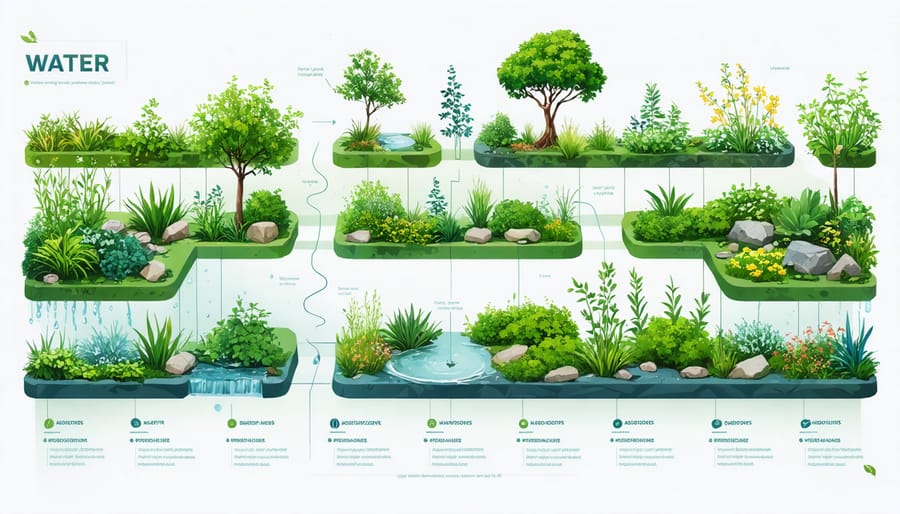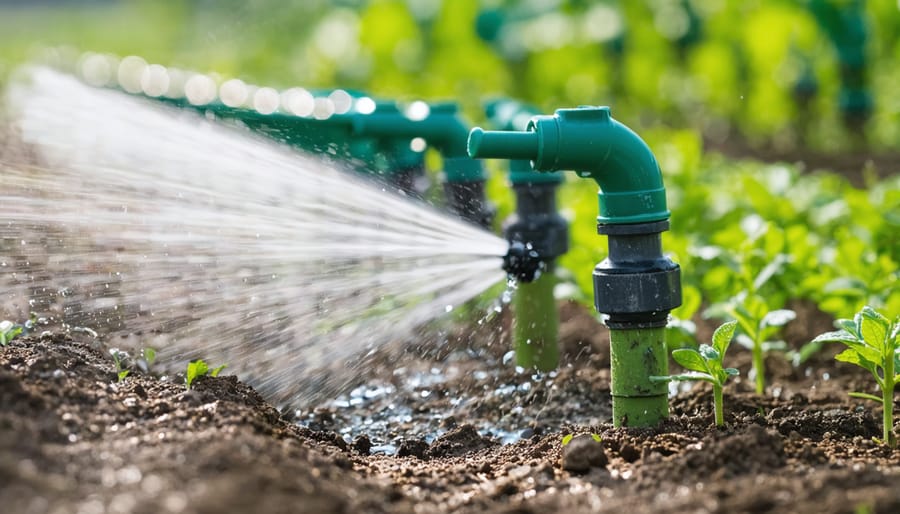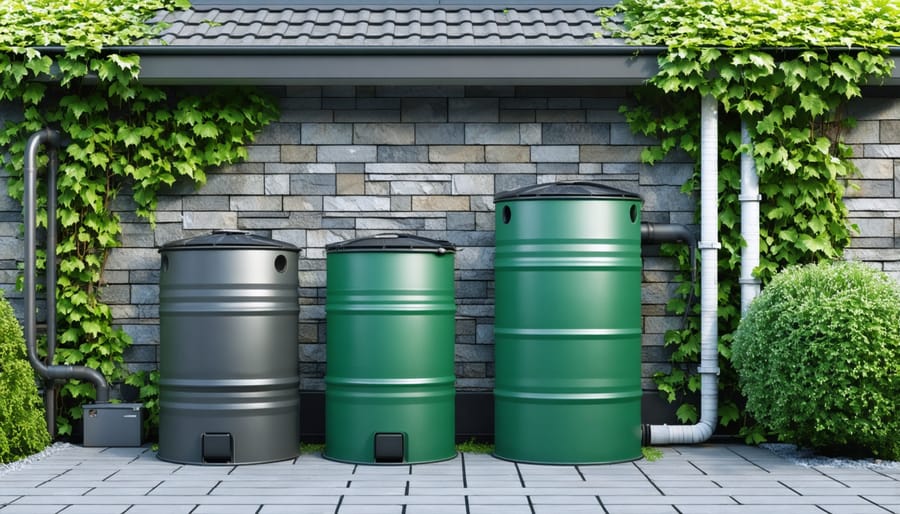Transform your garden into a water-wise oasis by grouping plants with similar water needs together, creating dedicated hydrozones that reduce wasteful overwatering. Install a smart irrigation system with moisture sensors and drip lines, delivering precise amounts of water directly to plant roots while cutting consumption by up to 50%. Layer your soil with 3-4 inches of organic mulch to lock in moisture, prevent evaporation, and naturally suppress thirsty weeds, reducing weekly watering needs by as much as 30%.
Water conservation gardening isn’t just about saving resources – it’s about creating resilient, beautiful spaces that thrive in harmony with nature. By implementing these water-smart techniques, you’ll not only reduce your environmental impact but also enjoy lower maintenance costs and healthier plants that are better equipped to handle dry spells. Whether you’re working with a sprawling backyard or a modest patio container garden, these sustainable practices help ensure every drop counts while maintaining the lush, vibrant landscape you desire.
Design Your Garden for Maximum Water Efficiency
Zone Planning for Water Conservation
Zone planning, or hydrozoning, is a fundamental principle of climate-resilient garden design that can dramatically reduce water waste while keeping your plants thriving. The concept is simple: group plants with similar water needs together to create efficient watering zones.
Start by dividing your garden into three main hydrozone categories: high, moderate, and low water use areas. High-water zones might include vegetable gardens and moisture-loving plants, which need regular watering. Moderate zones typically contain established perennials and ornamental plants that can tolerate occasional dry spells. Low-water zones are perfect for drought-resistant natives and Mediterranean plants that rarely need supplemental watering.
When planning your zones, consider natural factors like sun exposure, wind patterns, and soil conditions. Place high-water zones in sheltered areas where moisture naturally collects, and position drought-tolerant plants on slopes or in naturally drier spots. This thoughtful arrangement means you’ll water each zone precisely according to its needs, avoiding both under and over-watering.
Remember to keep plants with similar root depths together within each zone. Shallow-rooted plants need frequent but light watering, while deep-rooted plants prefer less frequent but deeper soaking. By matching these characteristics, you’ll create a more efficient and sustainable watering schedule that saves both water and time.

Soil Preparation Secrets
The foundation of successful water conservation gardening lies in how you improve soil health and structure. Start by adding plenty of organic matter, such as compost, aged manure, or leaf mold, which acts like a sponge to retain moisture while improving drainage. A good rule of thumb is to incorporate 2-3 inches of compost into your top 6-8 inches of soil each season.
Adding vermiculite or coconut coir can significantly boost your soil’s water-holding capacity. These amendments create tiny pockets that store water and release it slowly to plant roots when needed. For clay-heavy soils, consider mixing in coarse sand to enhance drainage and prevent waterlogging.
Mulching is your secret weapon in moisture retention. Apply a 2-3 inch layer of organic mulch around your plants, keeping it slightly away from stems and trunks. Straw, wood chips, or shredded leaves work wonderfully. Not only does mulch slow evaporation, but it also gradually breaks down to enrich your soil further.
Don’t forget about soil testing! Understanding your soil’s pH and composition helps you make informed decisions about amendments. Most vegetables and flowers thrive in slightly acidic to neutral soil (pH 6.0-7.0), which also happens to be ideal for nutrient availability and beneficial microorganism activity.
Smart Irrigation Solutions

Drip Irrigation Systems
Drip irrigation systems are one of the most efficient ways to water your garden, delivering water directly to plant roots while minimizing waste through evaporation and overspray. These systems typically use 20-50% less water than traditional sprinklers, making them an excellent choice for water-conscious gardeners.
Setting up a basic drip system is simpler than you might think. Start by connecting the main line to your outdoor faucet using a backflow preventer and pressure regulator. From there, run the main irrigation tubing around your garden beds, securing it with ground stakes every few feet. Add emitters near each plant, choosing the appropriate flow rate based on plant size and water needs – typically 0.5 to 2 gallons per hour for most garden plants.
For maximum efficiency, consider these maintenance tips:
– Flush the system monthly by removing end caps and running water through for a few minutes
– Check emitters regularly for clogs and clean them with a simple vinegar solution
– Install a timer to automate watering schedules
– Add a rain sensor to prevent unnecessary watering during wet weather
Pro tip: Group plants with similar water needs on the same irrigation line, and use pressure-compensating emitters to ensure even water distribution throughout your garden. For container plants, specialized micro-tubing and stakes can deliver precise amounts of water right where needed.
Remember to adjust your system seasonally, reducing watering times during cooler months and increasing during peak growing seasons. With proper setup and maintenance, a drip system can provide years of efficient, water-smart gardening.
Smart Controllers and Sensors
Modern technology has revolutionized the way we approach garden irrigation, making water conservation easier and more efficient than ever before. Smart controllers and sensors work together to create a precise watering system that delivers exactly what your plants need, when they need it.
Weather-based smart controllers act like garden meteorologists, automatically adjusting your watering schedule based on local weather conditions. These clever devices connect to WiFi to access real-time weather data, reducing water waste by preventing irrigation during rainy periods or adjusting water volume based on temperature and humidity levels.
Soil moisture sensors are your garden’s underground reporters, providing real-time feedback about soil conditions. Placed strategically throughout your garden, these sensors measure the exact moisture content in your soil and communicate with your controller to prevent overwatering. When the soil is adequately moist, the system automatically skips scheduled watering cycles.
Flow sensors add another layer of intelligence by monitoring water usage and detecting leaks. If there’s unusual water flow – perhaps from a broken pipe or malfunctioning sprinkler – these sensors can automatically shut off the system and alert you through a smartphone app.
Many modern systems also offer convenient mobile apps that put control literally in your hands. You can adjust watering schedules, monitor moisture levels, and receive alerts about potential issues, all from your phone. Some systems even integrate with smart home platforms, making them part of your broader home automation setup.
While the initial investment in smart irrigation technology might seem significant, the water savings typically offset the costs within a few seasons. Plus, the peace of mind knowing your garden is receiving optimal care while conserving water is invaluable.
Water Recycling and Collection
Rainwater Harvesting
Rainwater harvesting is one of the most effective ways to reduce your garden’s reliance on municipal water supplies while providing your plants with natural, chemical-free water. The simplest system starts with a rain barrel positioned under your roof’s downspout, which can collect hundreds of gallons of water during a single rainfall.
For those ready to take water collection to the next level, installing multiple interconnected rain barrels or a larger cistern system can dramatically increase your storage capacity. Underground tanks offer an excellent solution for gardeners with limited space, storing thousands of gallons while keeping your garden aesthetically pleasing.
To maximize collection efficiency, consider installing a first-flush diverter, which filters out initial roof runoff containing debris and contaminants. Gravity-fed distribution systems can help you easily water your garden using the collected rainwater, while a simple pump system allows for more precise irrigation control.
Don’t forget about smaller collection methods too! Rain chains can replace traditional downspouts, creating beautiful water features while directing rain to collection points. Even setting up a series of strategically placed rain gardens can help capture and utilize rainfall before it runs off your property.
Remember to check local regulations regarding rainwater harvesting, as some areas have specific requirements or restrictions. Regular maintenance of your collection system, including cleaning gutters and checking for leaks, will ensure optimal performance year-round.

Greywater Systems
Greywater systems offer an eco-friendly way to reuse household water from sinks, showers, and washing machines in your garden. By redirecting this gently used water, you can significantly reduce your garden’s freshwater consumption while maintaining its vitality.
The simplest way to start is by collecting shower water in buckets or installing a basic diversion system from your washing machine. Remember that only biodegradable, plant-friendly soaps should be used if you plan to reuse the water. Avoid water containing bleach, harsh chemicals, or food particles.
For a more permanent solution, consider installing a dedicated greywater system. These systems filter and distribute water through subsurface irrigation, keeping the water away from edible portions of plants and preventing any direct contact with people or pets. Popular options include mulch basins around trees and branched drain systems that distribute water to multiple planting areas.
When using greywater, it’s best to:
– Rotate watering zones to prevent soil saturation
– Use mulch to filter water and prevent splashing
– Label all greywater pipes and outlets
– Regular system maintenance to prevent clogs
Before installing a greywater system, check local regulations as requirements vary by region. Many areas now encourage greywater use and offer incentives for installation. Start small, observe how your plants respond, and adjust your system accordingly.
Drought-Resistant Planting Strategies
Best Water-Wise Plants
Creating a water-wise garden starts with selecting the right drought-tolerant plants that naturally thrive with minimal watering. Lavender, with its aromatic purple blooms, makes an excellent choice and adds a lovely Mediterranean touch to any garden. Salvias, known for their vibrant spikes of flowers, attract pollinators while requiring very little maintenance.
For ground cover, consider Sedum varieties, which store water in their thick leaves and create beautiful carpets of color. Native plants like Black-Eyed Susans and Coneflowers are perfectly adapted to local conditions and rainfall patterns, making them ideal choices for sustainable gardens.
Ornamental grasses such as Blue Fescue and Mexican Feather Grass add movement and texture while being incredibly water-efficient. For those wanting year-round interest, succulents and cacti offer fascinating shapes and structures, thriving in sunny, dry conditions.
Remember to group plants with similar water needs together to maximize efficiency. This practice, known as hydrozoning, ensures that no plant receives more or less water than it needs to flourish.
Mulching Techniques
Mulching is one of the most effective ways to conserve water in your garden while improving soil health. A good 2-3 inch layer of mulch can reduce water evaporation by up to 70% and keep your plants’ roots cool and moist. For vegetable gardens and flower beds, organic mulches like straw, shredded leaves, or grass clippings work wonderfully. These materials gradually break down, enriching your soil with nutrients.
Wood chips and bark mulch are excellent choices for trees and shrubs, offering longer-lasting protection and a polished look. For maximum moisture retention, apply mulch when the soil is already moist, and maintain a small mulch-free zone around plant stems to prevent rot.
Consider using living mulches like low-growing ground covers between larger plants. These not only retain moisture but also add beauty to your garden. Sheet mulching, also known as lasagna gardening, involves laying down alternating layers of brown and green materials, creating a moisture-retaining barrier that gradually enriches your soil.
Remember to refresh your mulch layer periodically as it decomposes or gets displaced by wind and rain.
Water conservation gardening isn’t just a trend; it’s a vital practice that benefits both our environment and our wallets. By implementing the techniques we’ve discussed, you can create a thriving garden that uses significantly less water while still producing beautiful results. Remember that every small change matters, whether it’s installing a drip irrigation system, choosing drought-resistant plants, or adding a layer of mulch to retain moisture.
The beauty of water-wise gardening lies in its flexibility – you can start small and gradually expand your efforts as you become more comfortable with these practices. Consider beginning with simple steps like collecting rainwater or adjusting your watering schedule, then progress to more advanced solutions like installing smart irrigation systems or redesigning your garden layout.
As climate patterns continue to change and water becomes an increasingly precious resource, your efforts in water conservation gardening will become even more valuable. Not only will you be creating a more sustainable environment, but you’ll also be inspiring others in your community to follow suit.
Don’t feel pressured to implement everything at once. Start with the methods that best suit your garden’s specific needs and your lifestyle. With time and patience, you’ll develop a garden that’s not only water-efficient but also a source of pride and joy. Remember, every drop saved is a step toward a more sustainable future for our gardens and our planet.




